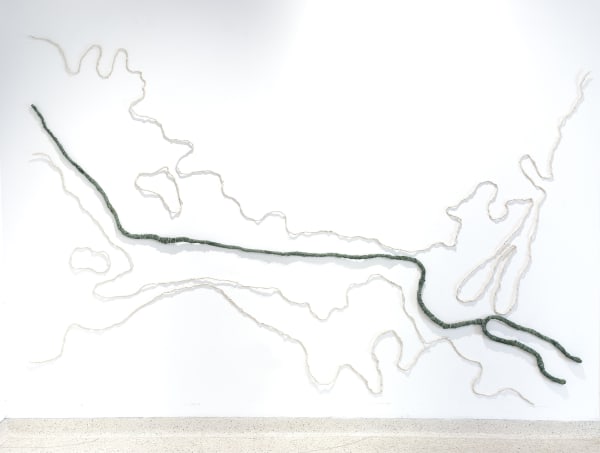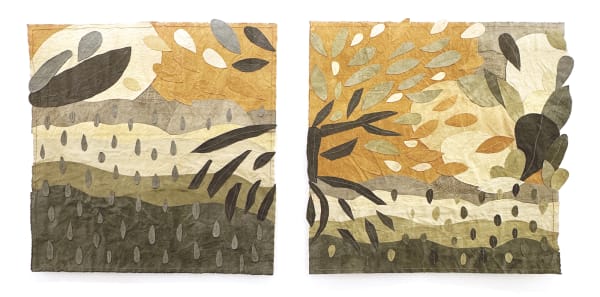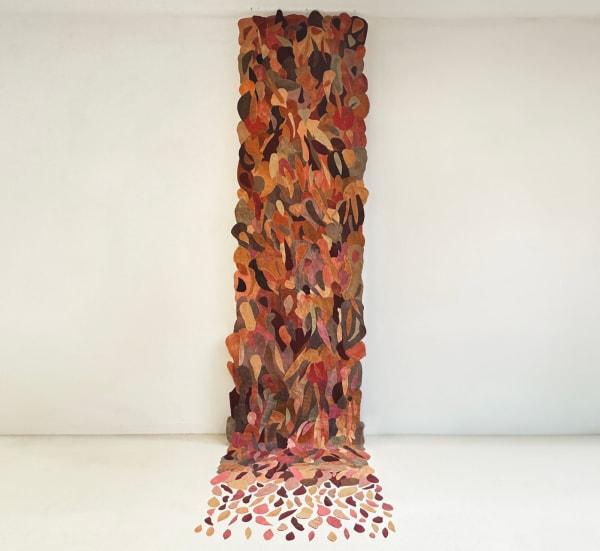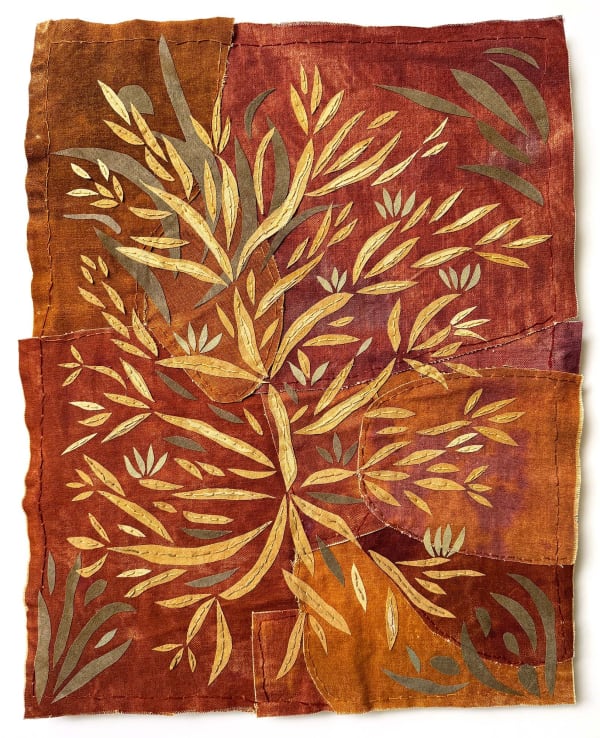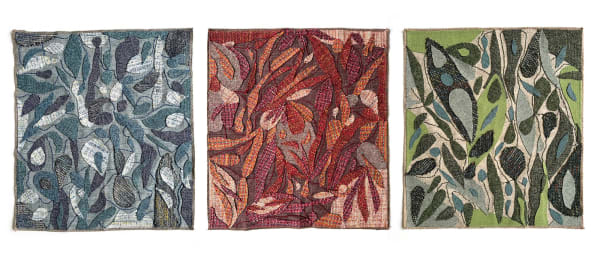Fernanda Froes' work displays a transversal gaze that moves from one realm of nature to another in various series, in search of a key that will return the trace of the primordial connection between living beings. A key that our Western culture lost in its vertiginous march towards forms of domination that were devastating to plants and animals, finally endangering even our own species. In her extensive series inspired by the tree that gave its name to Brazil ─Ibirapitanga or Pau-Brasil─ which was exploited until it approached extinction, there is a delicate gesture of reinvention that extends its existence. In her Indigo Landscapes, the blue regions on cotton paper, created with Indigofera tinctoria dyes from Asia, Africa, and Central and South America, evoke the origins and currents of the expansion of its usage, and its lucrative exploitation following the Conquest.
Froes transports the domains of the prodigious and varied botanical dyes into the realm of artistic imagination, revealing their intersections with the history of the America-a land that generated the very notion of utopia while being marked by multiple colonialist dystopias. At the same time, the whiteness of her paper reliefs inspired by the movement of those borderless creatures that are the mangroves, compelled to migrate by climate change, she reflects the alarming extent of their disappearance caused by the vortex of human impact. In her no less delicate insect pieces, Froes explores the architectures that these small creatures employ in building their habitats as a way to invoke models of human cooperation in a time that urgently requires the coming together of diverse groups within the same species. Following the understanding of Lévi-Strauss, her work essentially begins with identification with all forms of life, starting with the humblest, as a fundamental gesture of collective wisdom.
Adriana Herrera, PhD
Independent writer and curator
Co-founder Aluna Art Foundation
________________
O trabalho de Fernanda Froes exibe um olhar transversal que se move de um domínio da natureza para outro em várias séries, em busca de uma chave que retorne o traço da conexão primordial entre os seres vivos. Uma chave que nossa cultura ocidental perdeu em sua marcha vertiginosa em direção a formas de dominação que foram devastadoras para plantas e animais, ameaçando finalmente até mesmo nossa própria espécie. Em sua extensa série inspirada na árvore que deu nome ao Brasil – Ibirapitanga ou Pau-Brasil – que foi explorada até quase a extinção, há um gesto delicado de reinvenção que estende sua existência.
Em suas Paisagens de Índigo, as regiões azuis sobre papel de algodão, criadas com pigmentos de Indigofera tinctoria da Ásia, África e América Central e do Sul, evocam as origens e correntes da expansão de seu uso, e sua exploração lucrativa após a Conquista.
Froes transporta os domínios dos prodigiosos e variados pigmentos botânicos para o reino da imaginação artística, revelando suas interseções com a história das Américas - uma terra que gerou a própria noção de utopia enquanto era marcada por múltiplas distopias colonialistas. Ao mesmo tempo, a brancura de seus relevos em papel inspirados pelo movimento dessas criaturas sem fronteiras que são os manguezais, obrigadas a migrar pela mudança climática, ela reflete a extensão alarmante de seu desaparecimento causado pelo vórtice do impacto humano.
Em suas delicadas peças de insetos, Froes explora as arquiteturas que essas pequenas criaturas empregam na construção de seus habitats como uma forma de invocar modelos de cooperação humana em um momento que urgentemente requer a união de diversos grupos dentro da mesma espécie. Seguindo a compreensão de Lévi-Strauss, seu trabalho essencialmente começa com a identificação com todas as formas de vida, começando pelas mais humildes, como um gesto fundamental de sabedoria coletiva.
Adriana Herrera, PhD
Escritora e curadora independente
Co-fundadora da Fundação Aluna Art
-
 Replanta Primeva, after Remedios Varo, 2025
Replanta Primeva, after Remedios Varo, 2025 -
 Hidden River, 2024
Hidden River, 2024 -
 Remangue, 2024
Remangue, 2024 -
 Herbarium Rubro, 2022
Herbarium Rubro, 2022 -
 Flora Fantastica, 2024
Flora Fantastica, 2024 -
 Utopic Forest (with a Place in America), 2023
Utopic Forest (with a Place in America), 2023 -
 Utopic Forest VI and IX (with a Place in America), 2023
Utopic Forest VI and IX (with a Place in America), 2023 -
 Utopic Flora (with a Place in America), 2022
Utopic Flora (with a Place in America), 2022 -
 Utopic Flora ll (with a Place in America), 2023
Utopic Flora ll (with a Place in America), 2023 -
 Core, 2023
Core, 2023 -
 Core II, 2023
Core II, 2023 -
 Utopia Botanica l, 2023
Utopia Botanica l, 2023 -
 Utopia Botanica ll, 2023
Utopia Botanica ll, 2023 -
 Word Shroud, 2023
Word Shroud, 2023 -
 Forest Shroud, 2023
Forest Shroud, 2023 -
 Seven Million, 2023
Seven Million, 2023 -
 Countless, 2023
Countless, 2023 -
 Countless II, 2023
Countless II, 2023 -
 Imaginary Flora, 2023
Imaginary Flora, 2023 -
 Imaginary Words, 2023
Imaginary Words, 2023 -
 Displaced Treasures, 2023
Displaced Treasures, 2023 -
 Vanishing Names, 2024
Vanishing Names, 2024 -
 Beyond the Forest, 2024
Beyond the Forest, 2024 -
 Escambo, 2023
Escambo, 2023 -
 Herbarium Indigo, 2024
Herbarium Indigo, 2024 -
 Indigo Landscapes - Three Continents (triptych), 2023
Indigo Landscapes - Three Continents (triptych), 2023 -
 Indigo Landscapes - Three Continents II, III, and IV, 2023
Indigo Landscapes - Three Continents II, III, and IV, 2023 -
 Metamangrove, 2024
Metamangrove, 2024 -
 Replanta (After "Planta" from Remedios Varo -1960), 2024
Replanta (After "Planta" from Remedios Varo -1960), 2024 -
 Invisibilia Herbarium on Limestone, 2023
Invisibilia Herbarium on Limestone, 2023 -
 Invisibilia Herbarium, 2023
Invisibilia Herbarium, 2023 -
 Invisibilia Herbarium, 2023
Invisibilia Herbarium, 2023 -
 Regenerating Amazonia, Prepona narcissus, 2021
Regenerating Amazonia, Prepona narcissus, 2021 -
 Regenerating Amazonia, Morpho Deidamia, 2023
Regenerating Amazonia, Morpho Deidamia, 2023 -
 Swarm connections, Four Ants, Four Bees, Four Wasps, 2023
Swarm connections, Four Ants, Four Bees, Four Wasps, 2023 -
 Swarm connections, Eight Ants, Eiight Bees, Eight Wasps, 2023
Swarm connections, Eight Ants, Eiight Bees, Eight Wasps, 2023 -
 Swarm Homes - Installation, 2023
Swarm Homes - Installation, 2023 -
 Botanical Coverage, 2024
Botanical Coverage, 2024

